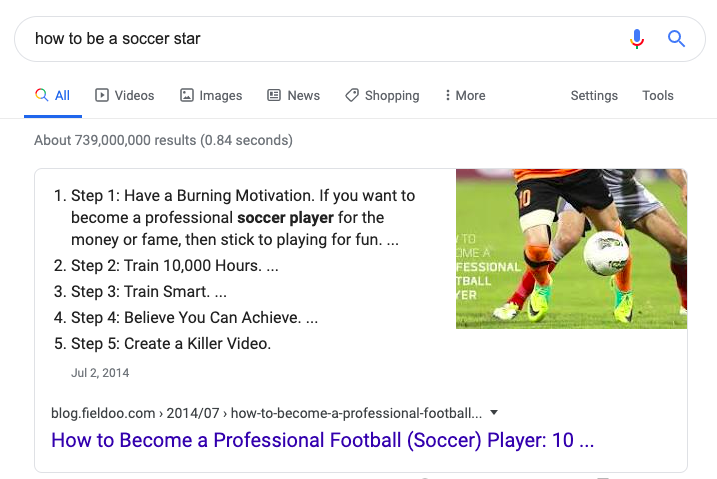Setting Company Culture Goals for Work
A strong company culture comes with innumerable benefits and can be your ticket to long-term organizational success. One study from CFO found…

Oftentimes, I’m brought in to drive traffic growth to blogs that have a high volume of content that was created, but receives very little consistent traffic due to a lack of SEO basics. These businesses usually invest in a content team that creates amazing content that receives page views during launch on social or via email, but then little traffic after.
So you might be asking yourself, how can I ensure I have the SEO basics, so my content gets viewed past the initial launch?The more your content is read/viewed, the more value you can attribute to your content program.
Here are a couple of examples that show content performance, pre and post SEO.
Example 1

This company struggled with consistency in traffic and leads as a result. Within 90 days of optimizing their great content, we started to see more consistency and an increase by about 250% in traffic to their existing content.
Example 2

This company went from around 5,000 visitors per week, to almost 20,000 visitors per week by implementing basic SEO principles into their blog content.
Example 3

This program went from a few visitors per week and zero leads as a result of blog SEO to a couple thousand per month to 70 leads per month and a demo request almost every day.
Example 4

With this company, we implemented basic SEO throughout the blog that doubled traffic (from 10,000 visitors/day to over 20,000 visitors/day) and added another $250k in monthly revenue as a result!
All of these companies knew they were creating great content, but without consistent viewership to their content, it was fizzling out.
So now, we get to the good stuff.
If these examples of other B2B and B2C websites traffic growth from existing content, haven’t already convinced you to make sure your content team knows the SEO basics, these facts will. If you’re already convinced, you can skip down to the last section with the most important SEO basics your team should know before and while they create their content.
Are you convinced yet?

The funny thing is SEO has received a bad rep over the years from over optimized content, and as a result several writers will actually refuse to write SEO content. Some writers hear SEO and think back to the keyword spamming days of the mid 2000’s.
That’s no longer the case as Google has made modifications to their search algorithms to detect better, more helpful, content. Overspamming of keywords can actually reduce your ranking positions.
So, without further ado, here are the SEO basics you’ve all been waiting for.
Your content team is always tasked with coming up with great ideas. But they need to start taking an extra step and using a keyword research tool to verify their ideas will deliver in ongoing traffic. We love SEMRush, but feel free to use any tool you’d prefer.
While conducting keyword research, one of the biggest mistakes we see is when content teams simply choose the keywords with the highest search volume. This is not the right approach to keyword selection. In fact, I often advise content teams to look for keywords with lower volume because they’ll be easier opportunities to take advantage of. Also, the keyword volume displayed tends to just be a rough estimate, and optimizing for a lower term may even yield in higher traffic volume than expected.
Before writing an article, I always recommend googling the terms you plan to optimize for. See what the top posts are and the most commonly asked questions, and frequently searched for options. These should give you an idea of what people are actually searching. You can then use the most common questions and include them in your content in order to address a searchers actual queries.
One of the most basic SEO concepts and easiest way to optimize your content are to leverage your H Tags. These are the headings that are used throughout the blog. The H1 is the main article title, the H2s are your sub heads, and H3s are the sub-sub headings. Make sure to include your keywords in each of these and to try and get the keyword as close to the beginning of each as possible. Also, as a general rule, you want to include a minimum of 3 H2s, and 3 H3s. With your H3s you can use different variations of your keywords, or other terms that may help associate your article with complimentary terms. For example, re-read this article and see what was used for the main headings as well as the sub headings. Every H3 in this article is being used as a complimentary term for the central keyword of “SEO Basics.”
Internal and external links are just what they sound like. Internal links are links from your blog to other articles or pages on your website. External links go to outside resources. Always link to at least 1 internal resources and 2 external resources. Google loves pages that share link equity because its algorithm views pages that link as ones that providing more related content and through leadership.
This is the controversial one. This is how many times you repeat the keyword in your article. I typically recommend using your main keyword once per paragraph, or as often as is natural without seeming spammy.
For every keyword you choose, there are most likely different variations. For example, “SEO Basics” can also be written as “basics for SEO”, “basic SEO concepts”, etc. You’ll want to include several different variations of your keyword so that your article will also be optimized for those terms.
Search engines love being able to easily understand your content, and so do readers. Using bulleted lists make your content easy to consume and it can be presented by search engines as rich snippets.
Example of a Rich Snippet

If using WordPress, your SEO page title can be edited once you install Yoast SEO. If you’re using a platform like Hubspot then you’ll be a bit more limited in your options. WordPress and Yoast are great for SEO because you can customize and edit your SEO title to align specifically with your keyword, and it will not impact your display heading or H1. However, Hubspot forces you to use your display heading or H1 as your SEO title. This means you cannot customize or have different versions for each without impacting the reader’s experience. (You can learn more about SEO ranking factors here)
Your meta description is another basic SEO concept that needs to be done right for best impact. Think of your meta description as an ad that is displayed in search engines. You get 155 characters to show that your article is relevant. We always recommend using the keyword twice in two short sentences to make sure that your meta description matches when users search for the targeted term. Remember the key with the meta description is showing relevancy.
The end goal for all content is to drive visitors to perform an action. Whether it’s downloading a new asset, subscribing for a blog, requesting a demo, or reading another article. You want to include at minimum a single call-to-action at the end of every article for visitors to follow. For bonus points, include a couple of other CTA’s throughout the body of your content as native calls-to-action.
Training your content writers in the basics of SEO is critical for today’s content teams. Using the above tips, your content team will be able to outperform 90% of competing content programs, and will empower them to build content that better resonates with your audience.
Become a hypergrowth marketer for free. Get the hypergrowth newsletter right to your inbox.

A strong company culture comes with innumerable benefits and can be your ticket to long-term organizational success. One study from CFO found…

Setting both long and short term objectives for individuals, departments, and the business as a whole keep a company on-track…

Growth marketing and demand generation are two concepts that I’m very familiar with, and often find that they are used…